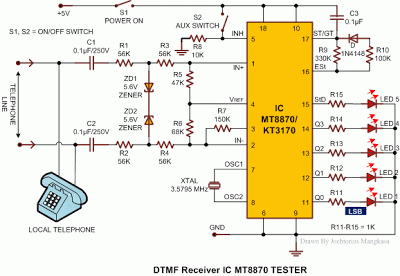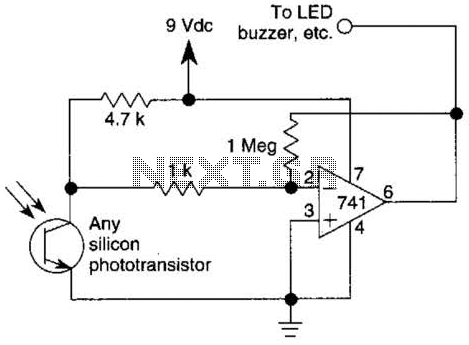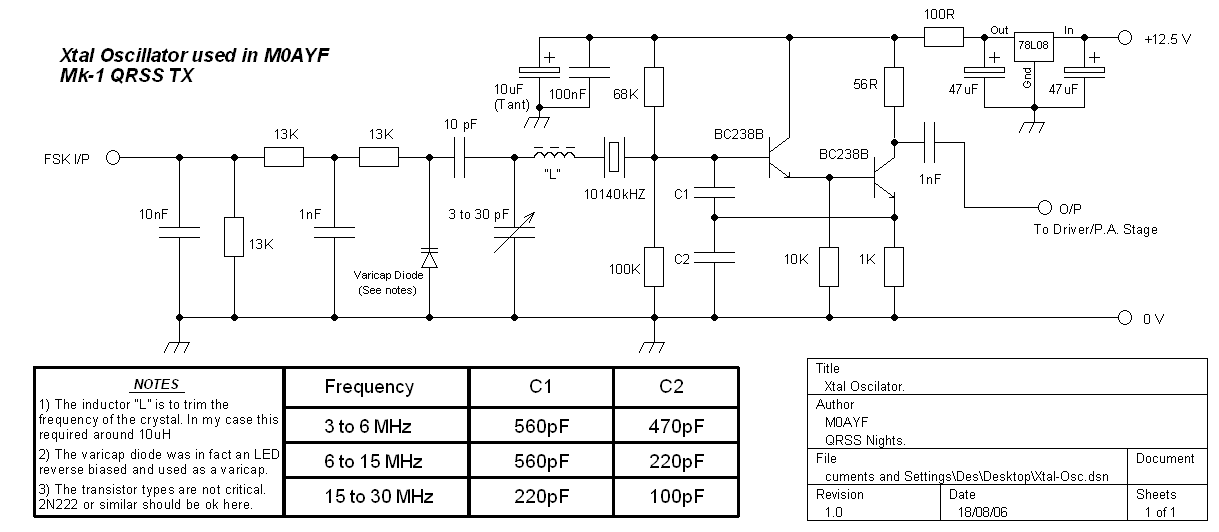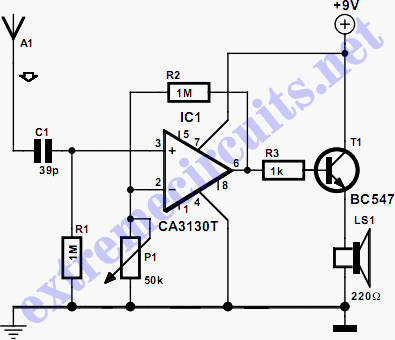
induction receiver
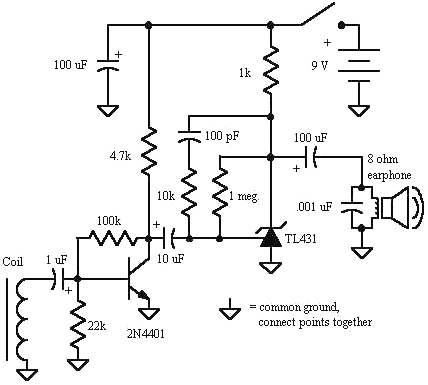
The induction receiver described is highly sensitive and versatile, suitable for various applications including tracing wiring behind walls, receiving audio from an induction transmitter, detecting lightning and other electrical discharges, and monitoring devices that produce an audio magnetic field, such as a telephone pickup coil. The receiving coil can be a telephone pickup coil or an appropriate coil from another device. The prototype used a coil salvaged from a surplus 24-volt relay, requiring two relays due to damage during the removal of surrounding metal to retain a single solenoid. Epoxy putty was employed to secure the thin wires, making the process somewhat challenging. A reed relay coil can be used for reduced sensitivity and ease of use. Experimentation with increasing the inductance of a reed relay by replacing the reed switch with soft iron is encouraged. Shielded inductors or those with iron pole pieces should be avoided unless the iron can be removed. The ideal coil should resemble a simple solenoid, such as wire wrapped around a nail, and winding a custom coil is discouraged due to the number of necessary turns. Coils should be evaluated by listening, as those with insufficient inductance may produce a "tinny" sound with poor low-frequency response, while larger iron core coils may sound muffled. The prototype was successfully tested with a large 100 mH air core coil, though its size was impractical for this application. Other components, such as the 2N4401 NPN general-purpose small-signal transistor and the TL431 shunt voltage regulator (used as an audio amplifier), are not critical. The entire device functions as a low-noise, high-gain audio amplifier with the pickup coil at the input, and various amplifiers can be utilized. The circuit is housed in an 8 mm cassette box, featuring a power switch and earphone jack at the rear. The circuit board is made from pink countertop laminate, complementing the violet hue of the cassette box, with a battery fitting snugly inside and foam filling any remaining space. Video cassette boxes are preferred for projects over audio cassette boxes due to their sturdiness. Upon initial activation, a significant buzzing from nearby wiring may be heard. The receiver should be rotated horizontally to locate a "null" point where the hum is minimal. If a null is achieved, distant lightning crackles or other magnetic noises can be detected. If no null is found indoors, moving outside may help. The coil can be held near electronic devices, such as computer monitors or telephones, to trace power wires behind walls or ceilings by listening for an increase in hum as the coil approaches the wire, ensuring that current is flowing through the wires being traced. An experiment involving a line voltage lamp flasher can be conducted to facilitate tracing by producing an alternating buzz sound. Additionally, wires carrying alternating current in the audio range can be traced by connecting a signal generator to the wire and grounding both the generator and the far end of the wire to ensure current flow.
The induction receiver circuit operates primarily as a highly sensitive audio amplifier, leveraging the principles of electromagnetic induction to detect and amplify signals from a variety of sources. The design incorporates a receiving coil, which acts as an antenna for magnetic fields generated by electrical devices. The selection of the receiving coil is critical for optimal performance; while a telephone pickup coil is ideal, alternatives can be used provided they meet the necessary inductance requirements.
The circuit utilizes a 2N4401 transistor, which serves as the primary amplification element. This NPN transistor is well-suited for low-signal applications, providing sufficient gain to amplify the weak signals picked up by the coil. The TL431, typically a voltage reference, is repurposed in this design as an audio amplifier, showcasing the flexibility of electronic components in circuit design.
The physical construction of the circuit is housed within a durable 8 mm cassette box, which not only protects the components but also provides a compact and portable solution for field use. The layout of the circuit board, made from pink countertop laminate, is designed for both aesthetic appeal and functionality, ensuring that components are securely mounted and easily accessible.
For practical applications, the receiver can be utilized in various scenarios, such as tracing electrical wiring behind walls or detecting the presence of electrical discharges. The ability to locate a null point by rotating the receiver allows the user to minimize interference from ambient electrical noise, enhancing the clarity of the detected signals.
Overall, the design emphasizes ease of use and versatility, making it an effective tool for both hobbyists and professionals engaged in electrical troubleshooting and diagnostics. The circuit's adaptability to various coil types and configurations further enhances its utility, allowing users to experiment with different setups to achieve the desired performance.The induction receiver shown below is very sensitive and can serve a variety of purposes. It is excellent for tracing wiring behind walls, receiving audio from an induction transmitter, hearing lightning and other electric discharges, and monitoring a telephone or other device that produces an audio magnetic field ("telephone pickup coil"). The re ceiving coil could be a "telephone pickup coil" if available or a suitable coil from some other device. The coil in the prototype was salvaged from a surplus 24 volt relay. Actually, two relays were needed since the first was destroyed in the attempt to remove the surrounding metal so that a single solenoid remained.
Epoxy putty was used to secure the thin wires and the whole operation was a bit of a challenge. A reed relay coil will give reduced sensitivity but would be much easier to use. The experimentally inclined might try increasing the inductance of a reed relay by replacing the reed switch with soft iron. Avoid shielded inductors or inductors with iron pole pieces designed to concentrate the magnetic field in a small area or confine it completely (as in a relay or transformer) unless you can remove the iron.
The resulting coil should be a simple solenoid like wire wrapped around a nail. Don`t try to wind your own - it takes too many turns. Evaluate several coils simply by listening. Coils with too little inductance will sound "tinny" with poor low frequency response and other coils will sound muffled, especially larger iron core coils. This prototype was tested with a large 100 mH air core coil with superb results but the 2 inch diameter was just too big for this application.
The other components are not particularly critical. The 2N4401 can be just about any NPN general purpose small-signal transistor. The TL431 is a shunt voltage regulator but it is being used as an audio amplifier in this circuit. In fact, the whole device is nothing more than a low noise, high gain audio amplifier with a pickup coil connected to the input and other amplifiers will work equally well. The circuit is built into a 8 mm cassette box with the power switch and earphone jack in the back. The circuit board is a piece of pink countertop laminate which looks good against the violet hue of the cassette box.
The battery fits nicely into the box and a piece of foam fills in the remaining space. These video cassette boxes make nice project boxes, unlike audio cassette boxes which are too flimsy. When you first turn on the unit you will probably hear a lot of buzzing from the wiring in the room. Rotate the receiver in a horizontal plane to find a "null" where the hum is minimal. If you can get a reasonable null, you should be able to hear distant lightning crackles or other magnetic noises.
If you cannot get a null then go outside away from the building. Try holding the coil near electronic devices like your computer monitor, telephone (when in use), cell phone readout, etc. You can trace power wires behind a wall or ceiling by listening for a sharp increase in hum as the coil passes near the wire.
Make sure that current is flowing in the wires to be traced by turning on a lamp or other appliance. (Here is an experiment to try: Build a line voltage lamp flasher that can be connected to the circuit to be traced. The desired wire will now have an on and off buzz - buzz sound that will be easy to distinguish. I wonder if you could even identify a specific breaker or fuse ) Other wires can be traced if they are carrying alternating current in the audio range or a signal generator can be connected to produce the current.
Connect the generator to the wire to be traced and connect the generator`s "ground" to the house wiring ground. Also ground the far end of the wire you are tracing so that current flows in the wire. This ground connection can also just be a temporary wire laying on the floor running from the generator ground to the far end of the
🔗 External reference
The induction receiver circuit operates primarily as a highly sensitive audio amplifier, leveraging the principles of electromagnetic induction to detect and amplify signals from a variety of sources. The design incorporates a receiving coil, which acts as an antenna for magnetic fields generated by electrical devices. The selection of the receiving coil is critical for optimal performance; while a telephone pickup coil is ideal, alternatives can be used provided they meet the necessary inductance requirements.
The circuit utilizes a 2N4401 transistor, which serves as the primary amplification element. This NPN transistor is well-suited for low-signal applications, providing sufficient gain to amplify the weak signals picked up by the coil. The TL431, typically a voltage reference, is repurposed in this design as an audio amplifier, showcasing the flexibility of electronic components in circuit design.
The physical construction of the circuit is housed within a durable 8 mm cassette box, which not only protects the components but also provides a compact and portable solution for field use. The layout of the circuit board, made from pink countertop laminate, is designed for both aesthetic appeal and functionality, ensuring that components are securely mounted and easily accessible.
For practical applications, the receiver can be utilized in various scenarios, such as tracing electrical wiring behind walls or detecting the presence of electrical discharges. The ability to locate a null point by rotating the receiver allows the user to minimize interference from ambient electrical noise, enhancing the clarity of the detected signals.
Overall, the design emphasizes ease of use and versatility, making it an effective tool for both hobbyists and professionals engaged in electrical troubleshooting and diagnostics. The circuit's adaptability to various coil types and configurations further enhances its utility, allowing users to experiment with different setups to achieve the desired performance.The induction receiver shown below is very sensitive and can serve a variety of purposes. It is excellent for tracing wiring behind walls, receiving audio from an induction transmitter, hearing lightning and other electric discharges, and monitoring a telephone or other device that produces an audio magnetic field ("telephone pickup coil"). The re ceiving coil could be a "telephone pickup coil" if available or a suitable coil from some other device. The coil in the prototype was salvaged from a surplus 24 volt relay. Actually, two relays were needed since the first was destroyed in the attempt to remove the surrounding metal so that a single solenoid remained.
Epoxy putty was used to secure the thin wires and the whole operation was a bit of a challenge. A reed relay coil will give reduced sensitivity but would be much easier to use. The experimentally inclined might try increasing the inductance of a reed relay by replacing the reed switch with soft iron. Avoid shielded inductors or inductors with iron pole pieces designed to concentrate the magnetic field in a small area or confine it completely (as in a relay or transformer) unless you can remove the iron.
The resulting coil should be a simple solenoid like wire wrapped around a nail. Don`t try to wind your own - it takes too many turns. Evaluate several coils simply by listening. Coils with too little inductance will sound "tinny" with poor low frequency response and other coils will sound muffled, especially larger iron core coils. This prototype was tested with a large 100 mH air core coil with superb results but the 2 inch diameter was just too big for this application.
The other components are not particularly critical. The 2N4401 can be just about any NPN general purpose small-signal transistor. The TL431 is a shunt voltage regulator but it is being used as an audio amplifier in this circuit. In fact, the whole device is nothing more than a low noise, high gain audio amplifier with a pickup coil connected to the input and other amplifiers will work equally well. The circuit is built into a 8 mm cassette box with the power switch and earphone jack in the back. The circuit board is a piece of pink countertop laminate which looks good against the violet hue of the cassette box.
The battery fits nicely into the box and a piece of foam fills in the remaining space. These video cassette boxes make nice project boxes, unlike audio cassette boxes which are too flimsy. When you first turn on the unit you will probably hear a lot of buzzing from the wiring in the room. Rotate the receiver in a horizontal plane to find a "null" where the hum is minimal. If you can get a reasonable null, you should be able to hear distant lightning crackles or other magnetic noises.
If you cannot get a null then go outside away from the building. Try holding the coil near electronic devices like your computer monitor, telephone (when in use), cell phone readout, etc. You can trace power wires behind a wall or ceiling by listening for a sharp increase in hum as the coil passes near the wire.
Make sure that current is flowing in the wires to be traced by turning on a lamp or other appliance. (Here is an experiment to try: Build a line voltage lamp flasher that can be connected to the circuit to be traced. The desired wire will now have an on and off buzz - buzz sound that will be easy to distinguish. I wonder if you could even identify a specific breaker or fuse ) Other wires can be traced if they are carrying alternating current in the audio range or a signal generator can be connected to produce the current.
Connect the generator to the wire to be traced and connect the generator`s "ground" to the house wiring ground. Also ground the far end of the wire you are tracing so that current flows in the wire. This ground connection can also just be a temporary wire laying on the floor running from the generator ground to the far end of the
🔗 External reference
